硕士学位论文
基于ROS的移动操作机械臂底层规划
及运动仿真
ROS-BASED PLANNING AND MOTION
SIMULATION OF MOBILE MANIPULATOR
钱伟
哈尔滨工业大学
2014 年 12 月
�
国内图书分类号:TP24
学校代码:10213
国际图书分类号:629.7
密级: 公开
工学硕士学位论文
基于ROS的移动操作机械臂底层规划
及运动仿真
硕 士 研 究 生: 钱伟
导 师 : 陈明 助理教授
申 请 学 位 : 工学硕士
专
业 : 机械电子工程
所 在 单 位 : 深圳研究生院
答 辩 日 期 : 2014 年 12 月
授 予 学 位 单 位 : 哈尔滨工业大学
�
Classified Index: TP24
U.D.C: 629.7
Dissertation for the Master Degree in Engineering
ROS-BASED PLANNING AND MOTION
SIMULATION OF MOBILE MANIPULATOR
Candidate:
Affiliation:
Qian Wei
Assistant Prof. Chen Ming
Supervisor:
Academic Degree Applied for: Master of Engineering
Speciality:
Mechatronics Engineering
Shenzhen Graduate School
Date of Defence:
Degree-Conferring-Institution: Harbin Institute of Technology
December, 2014
�
哈尔滨工业大学工学硕士学位论文
摘 要
移动操作机械臂作为新型的机器人,在家庭服务中发挥着越来越重要的作
用,围绕其开展的技术研究也越来越多。本文主要对移动操作机械臂的仿真实
验平台搭建及路径规划方法进行了深入研究,形成了自己的观点和方法。
本文首先对冗余自由度机械臂的运动学展开研究,其中机械臂的连杆坐标
系建立及正向运动学较为简单,逆运动学的解决方法比较复杂。文中提出了手
臂三角形平面的概念并通过控制其旋转角度求出了目标位姿下的关节角度。通
过笛卡尔空间直线插值、圆弧插值以及自运动插值运动的方法验证了冗余机械
臂逆解的正确性。
移动操作机械臂是集机械臂、移动平台、传感器的复杂系统,因此仿真要
求比普通机器人更高。本文在开源机器人操作系统ROS下搭建了移动操作机械
臂的仿真平台。利用开源动力学仿真器Gazebo对笛卡尔空间的插值运动进行了
仿真,验证了仿真平台的有效性和可靠性。
路径规划是机器人运动首先需要解决的问题,移动操作机械臂在服务人类
的过程中不免会遇到动态障碍物,因而机器人的路径规划将面临更加严格的挑
战。本文通过改进传统的RRT算法并将其运用到动态环境中,实现了冗余自由
度机械臂在动态环境下的自主规划。
在仿真实验环节,利用ROS及Gazebo仿真平台完成了基于Kinect的抓取水
杯实验以及基于Kinect的开门实验。文章的最后一部分对动态RRT规划过程进行
了测试,证明了本文动态RRT算法的可行性。
关键词:移动操作机械臂;RRT规划;ROS;Gazebo仿真器;动态规划
I
�
哈尔滨工业大学工学硕士学位论文
Abstract
As a kind of novel robots, mobile manipulator plays a more and more important
role in domestic service. More and more researches around mobile manipulator have
been carried out. This dissertation presents a thorough research on the simulation
platform and motion planning of mobile manipulator, and also puts forward some
views and methods about the robot.
The first part of this dissertation focused on the kinematics analysis of the
redundant manipulator. It's a simple task to build link coordinate system and solve
forward kinematics problem while inverse kinematics issue is more complicated
than that of common 6 DOF manipulators. In this part, the notation called arm
triangular plane is presented, and then we can obtain current position of each joint
by fixing the revolute angle of the plane. The correctness and availability of the
inverse kinematics method are verified by line
interpolation, circular arcs
interpolation and self-motion interpolation in Cartesian space.
Mobile manipulator is a complex system that consists of mechanism arm,
mobile platform, sensors , etc. Thus it's more difficult to simulate mobile
manipulators than traditional robots. This dissertation focused on how to create
robot simulation platform based on the Robot Operating System (ROS). By making
use of the open-source dynamic simulator named Gazebo, it’s simple to simulate
Cartesian interpolation motion. The satisfying results prove the validity and
reliability of the mobile manipulator simulation platform.
Motion planning is the primary problem of robots' moving. When offering
services to human, mobile manipulator may encounter dynamic obstacles, in which
case, motion planning will become more challenging. In this dissertation, we
improve the traditional Rapidly-exploring Random Tree (RRT) algorithm and apply
it to the dynamic environment. The ability of motion planning among dynamic
obstacles has been significantly enhanced.
In the part of virtual experiments, we complete two virtual experiments:
grasping cup and opening door based on Kinect depth sensor. The last part of this
dissertation focuses on simulating the motion planned by dynamic RRT algorithm on
the ROS and Gazebo simulator. By testing the whole planning process of planning
and controlling, the availability of dynamic RRT algorithm is verified.
Keywords: mobile manipulator, Rapidly-exploring Random Tree (RRT), Robot
Operating System (ROS), Gazebo simulator, dynamic motion planning
II
�
哈尔滨工业大学工学硕士学位论文
目 录
摘要 .............................................................................................................................. I
ABSTRACT ................................................................................................................ II
第 1 章 绪 论 .......................................................................................................... 1
1.1 课题来源 .......................................................................................................... 1
1.2 课题研究的目的及意义 .................................................................................. 1
1.3 国内外相关技术发展现状 .............................................................................. 2
1.3.1 移动操作机械臂国内外现状 ................................................................... 2
1.3.2 机器人仿真系统国内外现状 ................................................................... 4
1.3.3 机器人高维空间路径规划 ....................................................................... 6
1.4 本文的主要研究内容 ...................................................................................... 7
第 2 章 冗余机械臂运动学建模与分析 .................................................................. 9
2.1 引言 .................................................................................................................. 9
2.2 机械臂正运动学 .............................................................................................. 9
2.3 机械臂逆运动学 ............................................................................................ 11
2.3.1 点位置的求解 .................................................................................... 13
2.3.2 手臂平面角度求解 ................................................................................. 13
2.3.3 点固连坐标系位姿求解 ..................................................................... 14
2.3.4 机械臂关节角度的求解 ......................................................................... 16
2.4 笛卡尔空间轨迹规划 .................................................................................... 16
2.4.1 直线轨迹插补 ......................................................................................... 17
2.4.2 圆弧轨迹插补 ......................................................................................... 19
2.4.3 冗余机械臂自运动插补 ......................................................................... 21
2.5 本章小结 ........................................................................................................ 22
第 3 章 基于ROS的仿真平台搭建 ........................................................................ 23
3.1 引言 ................................................................................................................ 23
3.2 ROS基本介绍 ................................................................................................ 23
3.3 ROS的基本组成 ............................................................................................ 23
3.4 机器人模型的导入 ........................................................................................ 25
3.5 Gazebo动力学仿真器 .................................................................................... 28
3.5.1 直线插值运动Gazebo仿真 ..................................................................... 28
III
WE�
哈尔滨工业大学工学硕士学位论文
3.5.2 圆弧插值运动Gazebo仿真 ..................................................................... 29
3.5.3 自运动插值运动Gazebo仿真 ................................................................. 30
3.6 本章小结 ........................................................................................................ 31
第 4 章 高维空间RRT规划及动态规划 ................................................................ 32
4.1 引言 ................................................................................................................ 32
4.2 传统RRT算法 ................................................................................................ 32
4.3 RRT算法 ........................................................................................................ 33
4.3.1 总体方案 ................................................................................................. 33
4.3.2 节点拓展 ................................................................................................. 34
4.3.3 碰撞检测 ................................................................................................. 35
4.3.4 轨迹优化 ................................................................................................. 36
4.4 静态RRT算法实验 ........................................................................................ 38
4.4.1 二维静态RRT算法实验 .......................................................................... 38
4.4.2 高维静态RRT算法实验 .......................................................................... 40
4.5 动态RRT算法实验 ........................................................................................ 42
4.5.1 二维动态RRT算法实验 .......................................................................... 43
4.5.2 高维动态RRT算法实验 .......................................................................... 45
4.6 本章小结 ........................................................................................................ 46
第 5 章 控制器设计及仿真实验 ............................................................................ 47
5.1 引言 ................................................................................................................ 47
5.2 Gazebo控制器设计 ........................................................................................ 47
5.3 仿真平台验证实验 ........................................................................................ 49
5.3.1 基于Kinect的抓取水杯实验 .................................................................. 49
5.3.2 基于Kinect的移动操作机械臂开门实验............................................... 52
5.3.3 动态RRT运动规划算法仿真实验 .......................................................... 54
5.4 本章小结 ........................................................................................................ 60
结 论 ....................................................................................................................... 61
参考文献 ................................................................................................................... 62
攻读硕士学位期间发表的论文及其它成果 ........................................................... 66
致 谢 ....................................................................................................................... 68
IV
�
哈尔滨工业大学工学硕士学位论文
第 1 章 绪 论
1.1 课题来源
本课题来源于国家自然科学基金项目,项目名称:面向任务的服务机器人
系统基础理论与关键技术。
1.2 课题研究的目的及意义
机器人诞生以来,人类按照其智能化的程度划分为三代:示教型机器人属
于第一代机器人,其智能化程度低但由于价格的低廉而商业应用最多;具有本
体传感器的感知型机器人属于第二代机器人,它能够感知自身状态及外部环境
信息,可以实现反馈运动控制;第三代智能机器人具有更强的感知能力以及前
两代机器人所缺乏的自主学习、决策能力,它包含了复杂的智能化信息处理系
统,目前该类机器人相关技术正处于研发阶段[1]。
工业机器人是迄今为止应用最为广泛的机器人 [2],它们被设计用来代替人
类从事具有重复性或者危险性的生产工作,例如:车体焊接、车身涂装、零件
装配等。机器人技术的不断发展使得机器人不再只应用于在工业制造[3],越来
越多的机器人正参与到人类的日常生活中,这类机器人统称为服务机器人[4]。
一般来讲,服务机器人属于第三代机器人,其具有前两代机器人没有的智能化
系统[5]。移动服务机器人具有行动能力,能够在人类生活环境中自由移动。如
图 1-1 所示为三种典型的移动服务机器人:递物机器人、扫地机器人和娱乐机
器人,它们的出现方便舒适了人们的生活[6],然而这三种机器人属于传统的移
动服务机器人,它们能够遵循人类指令完成特定的任务,但却存在功能单一,
自身没有足够执行能力,智能化程度较低等缺点。
a) 递物机器人
b) 扫地机器人
c) 娱乐机器人
图 1-1 三种传统的移动服务机器人
1
�
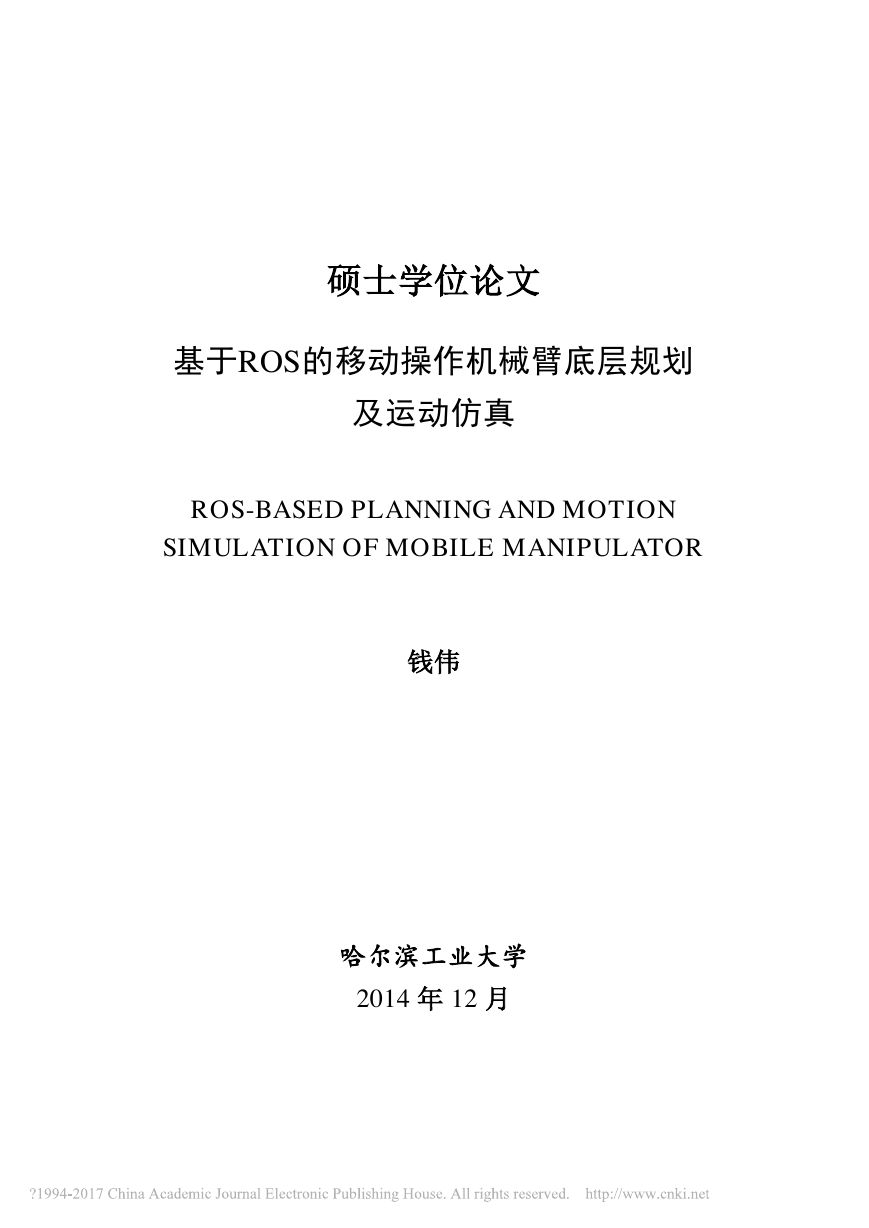
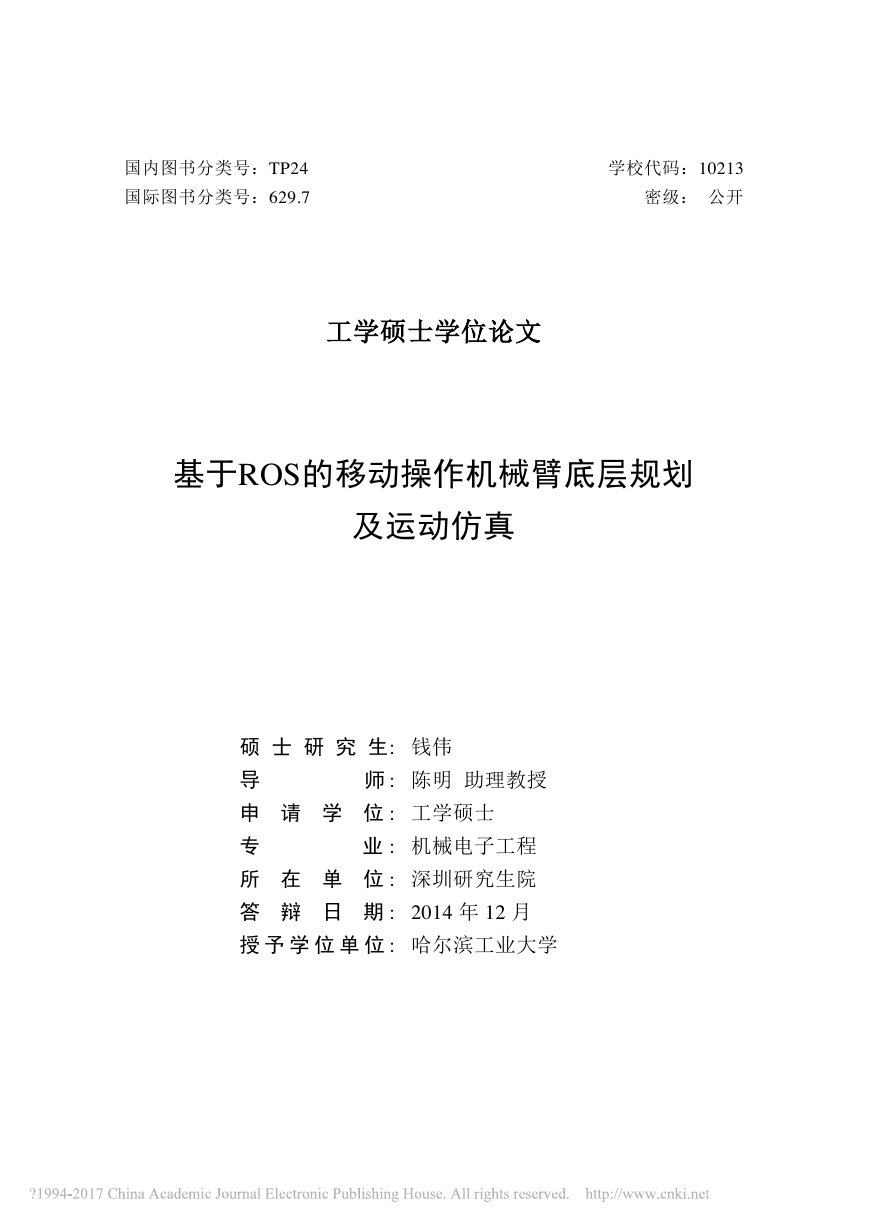
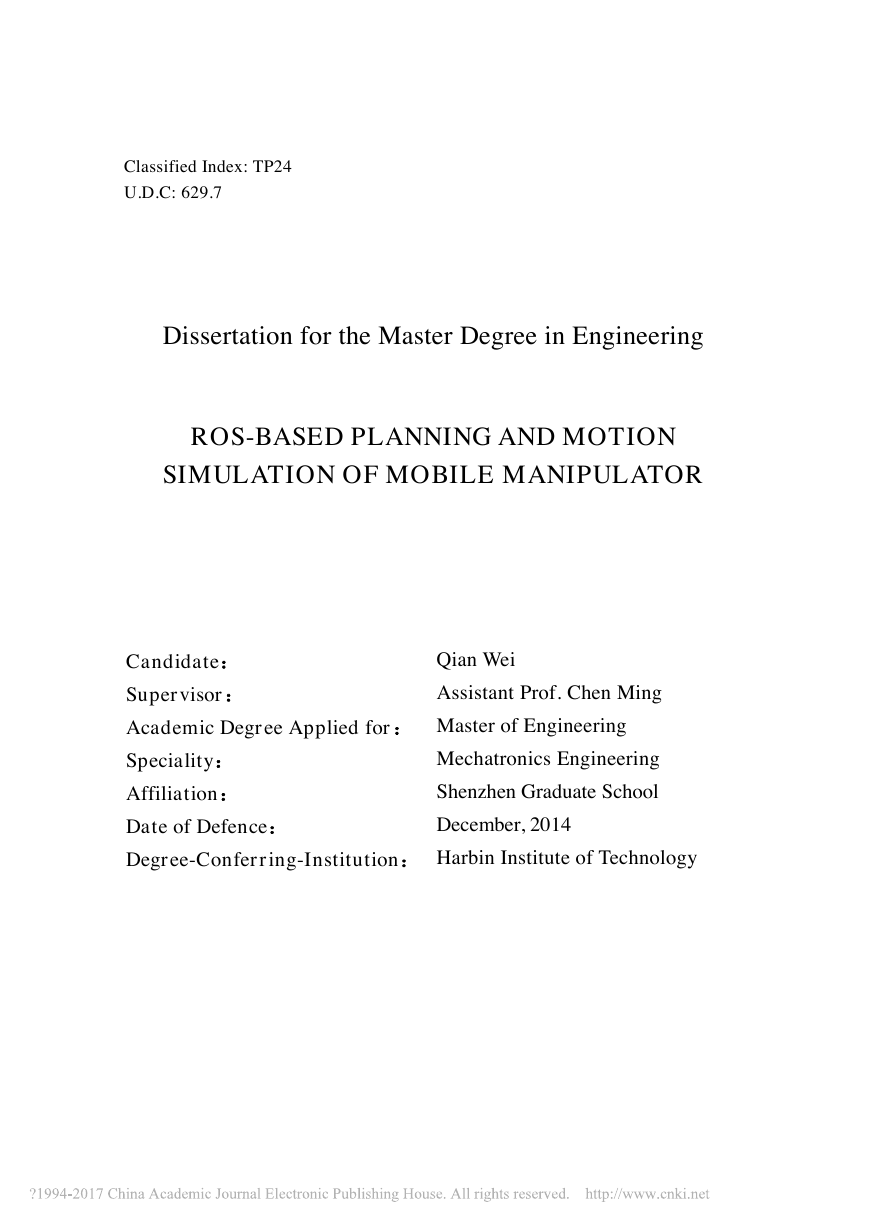
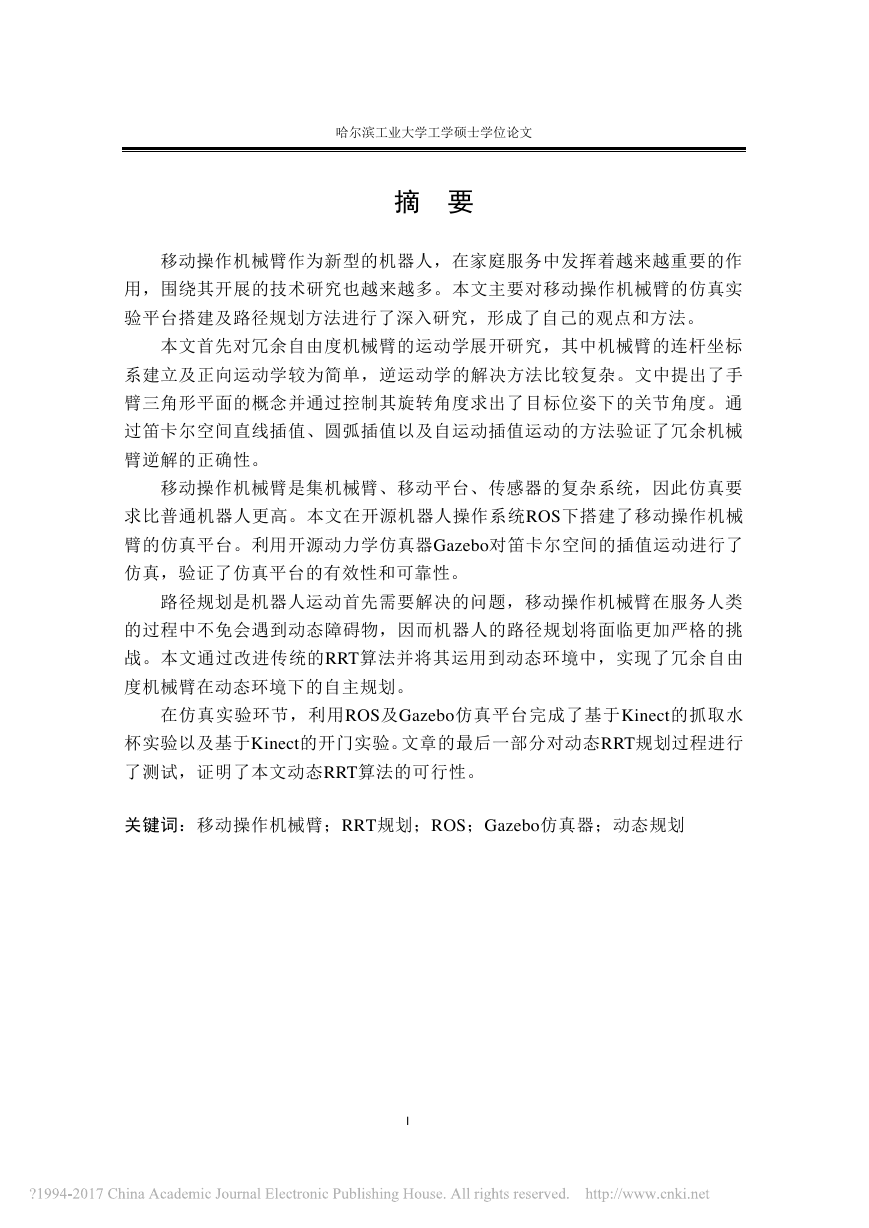
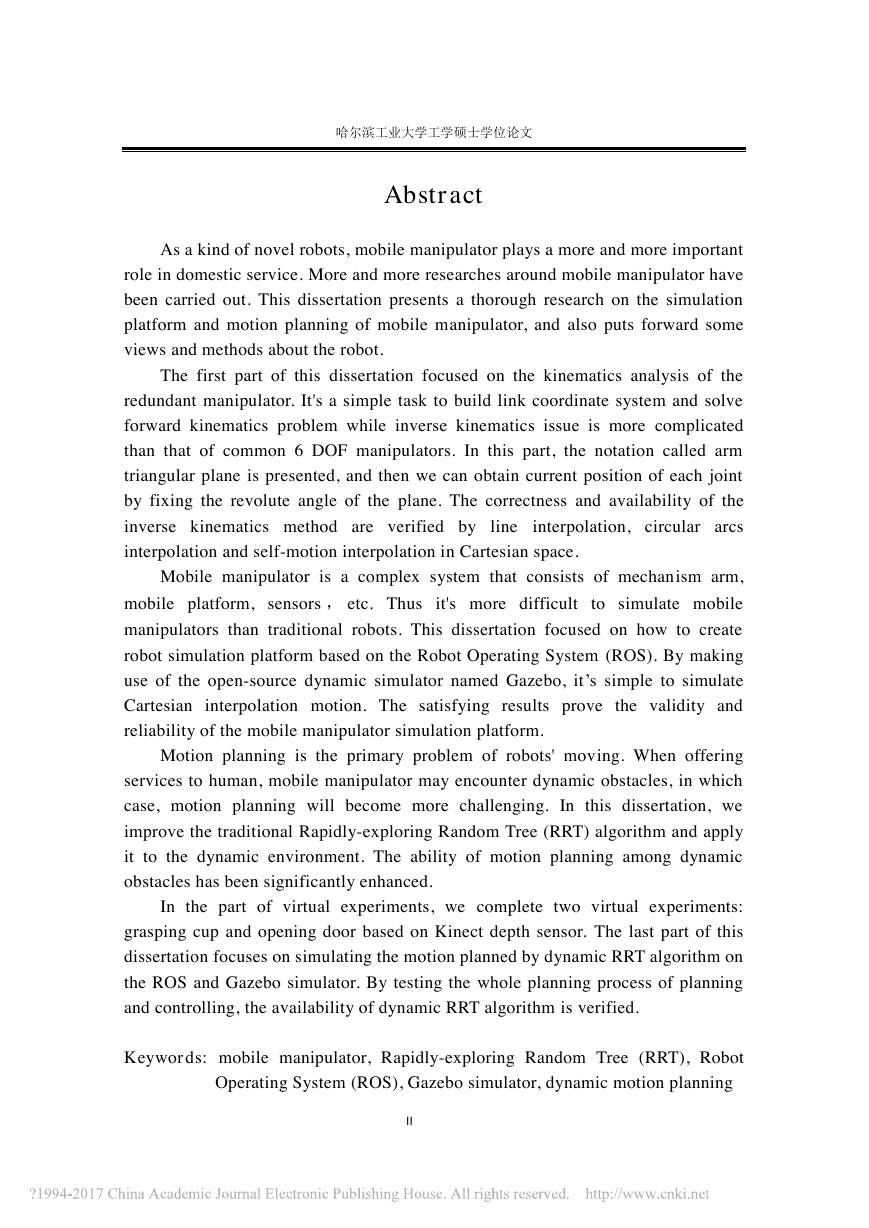
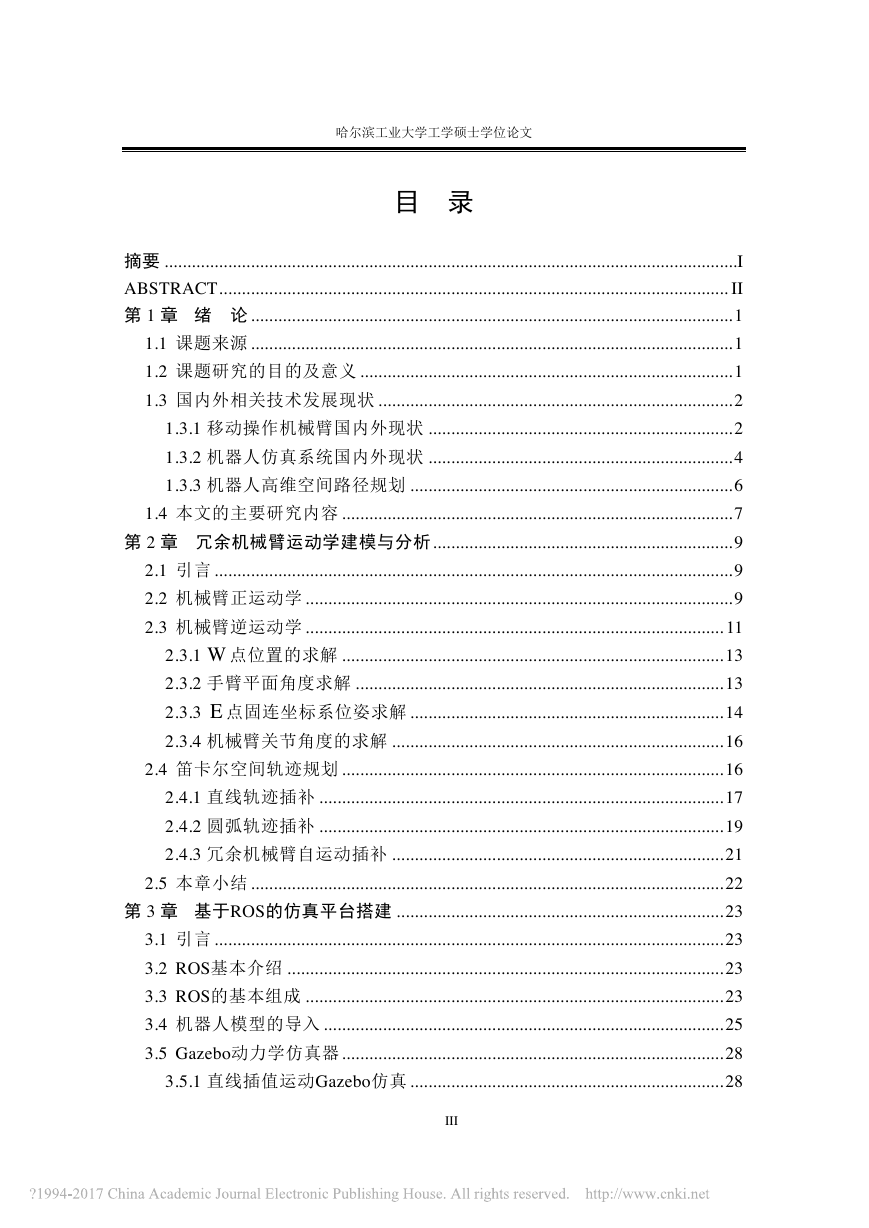
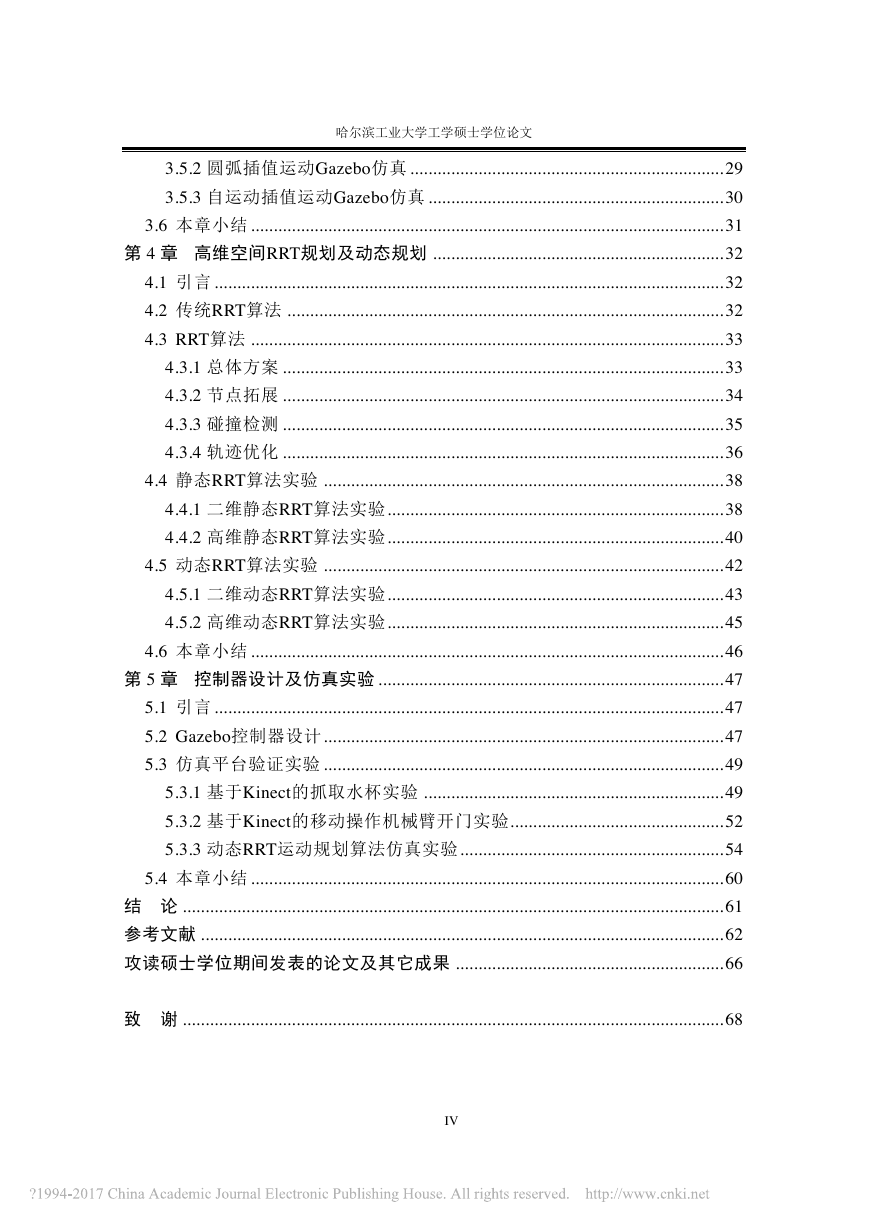
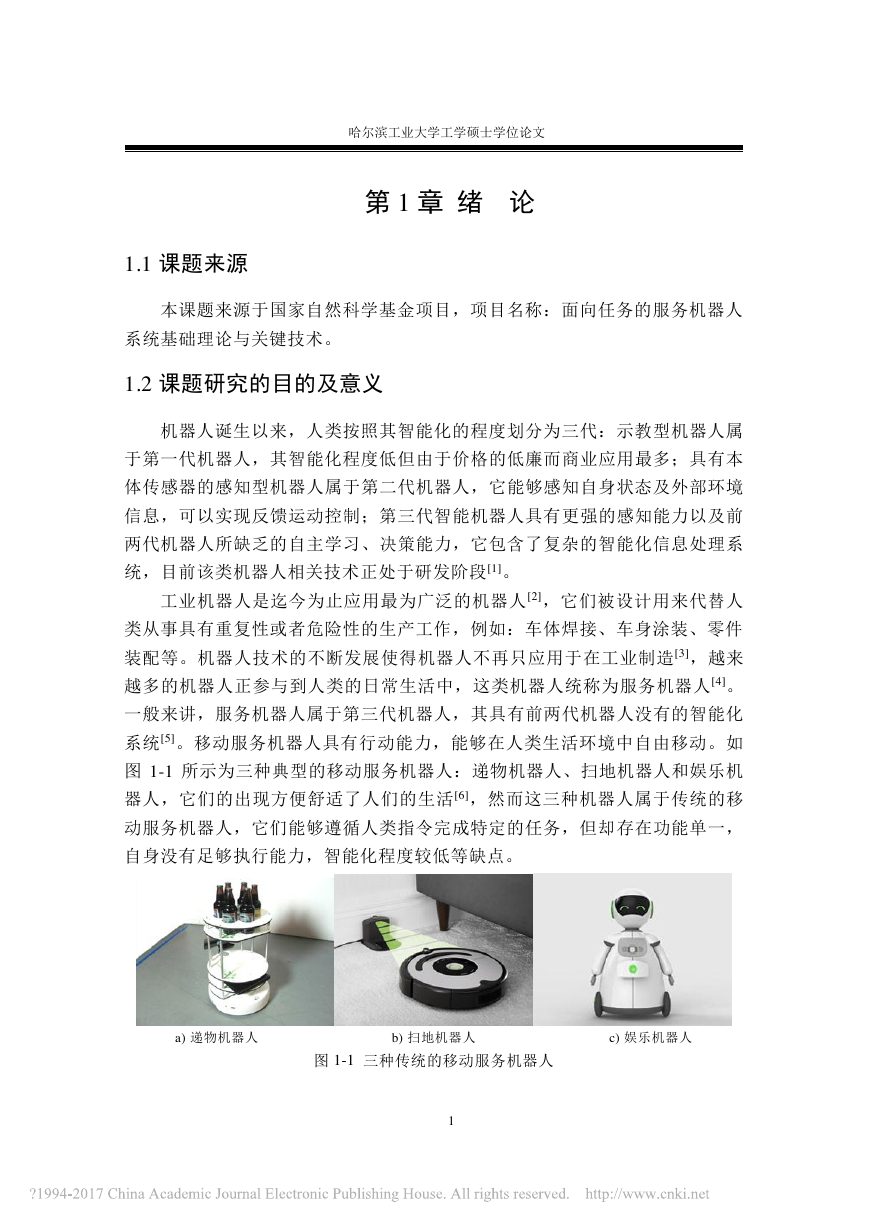








 2023年江西萍乡中考道德与法治真题及答案.doc
2023年江西萍乡中考道德与法治真题及答案.doc 2012年重庆南川中考生物真题及答案.doc
2012年重庆南川中考生物真题及答案.doc 2013年江西师范大学地理学综合及文艺理论基础考研真题.doc
2013年江西师范大学地理学综合及文艺理论基础考研真题.doc 2020年四川甘孜小升初语文真题及答案I卷.doc
2020年四川甘孜小升初语文真题及答案I卷.doc 2020年注册岩土工程师专业基础考试真题及答案.doc
2020年注册岩土工程师专业基础考试真题及答案.doc 2023-2024学年福建省厦门市九年级上学期数学月考试题及答案.doc
2023-2024学年福建省厦门市九年级上学期数学月考试题及答案.doc 2021-2022学年辽宁省沈阳市大东区九年级上学期语文期末试题及答案.doc
2021-2022学年辽宁省沈阳市大东区九年级上学期语文期末试题及答案.doc 2022-2023学年北京东城区初三第一学期物理期末试卷及答案.doc
2022-2023学年北京东城区初三第一学期物理期末试卷及答案.doc 2018上半年江西教师资格初中地理学科知识与教学能力真题及答案.doc
2018上半年江西教师资格初中地理学科知识与教学能力真题及答案.doc 2012年河北国家公务员申论考试真题及答案-省级.doc
2012年河北国家公务员申论考试真题及答案-省级.doc 2020-2021学年江苏省扬州市江都区邵樊片九年级上学期数学第一次质量检测试题及答案.doc
2020-2021学年江苏省扬州市江都区邵樊片九年级上学期数学第一次质量检测试题及答案.doc 2022下半年黑龙江教师资格证中学综合素质真题及答案.doc
2022下半年黑龙江教师资格证中学综合素质真题及答案.doc